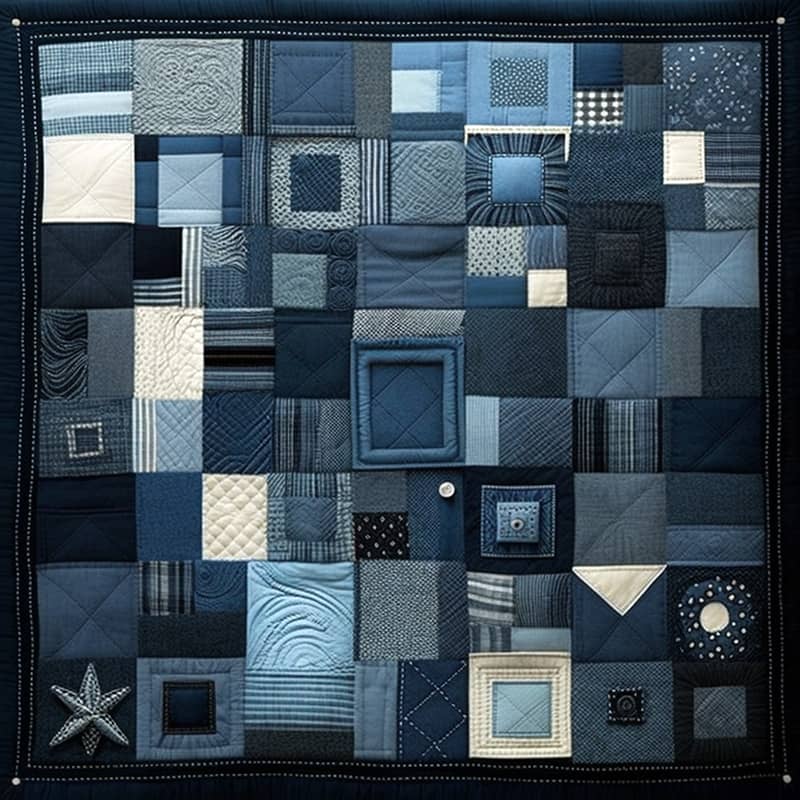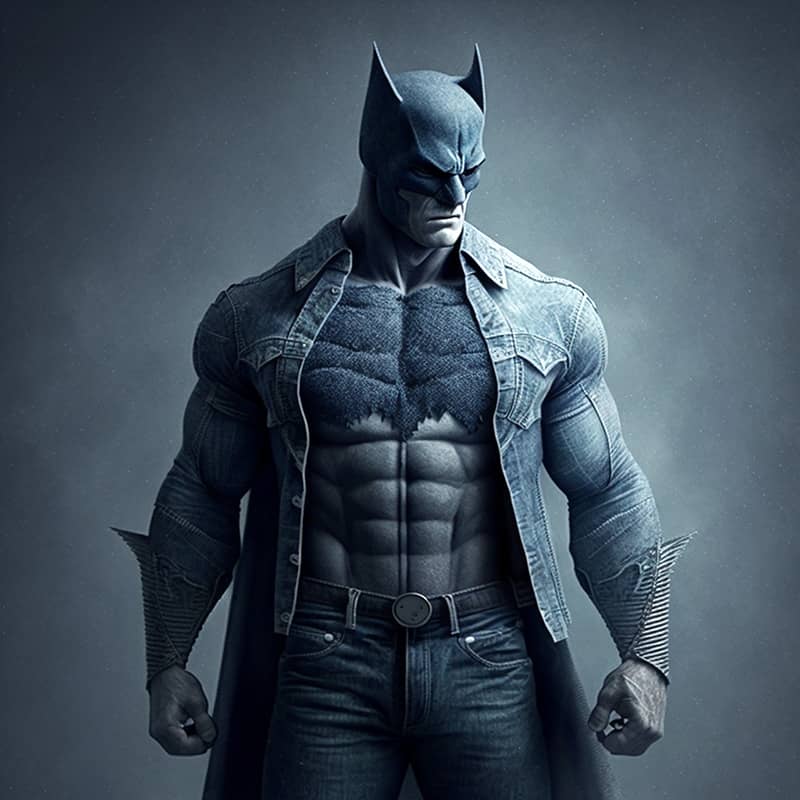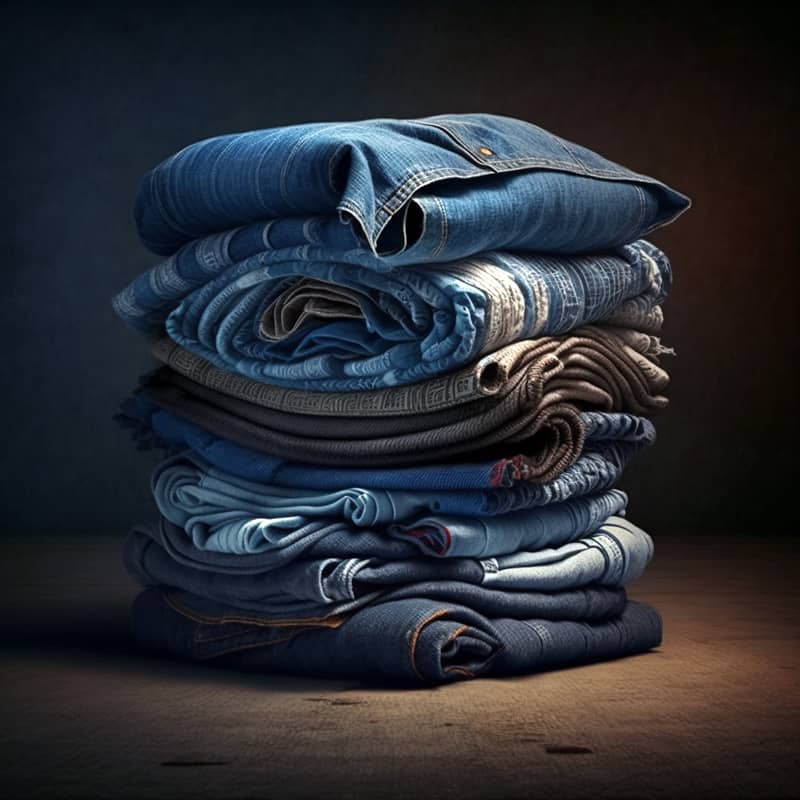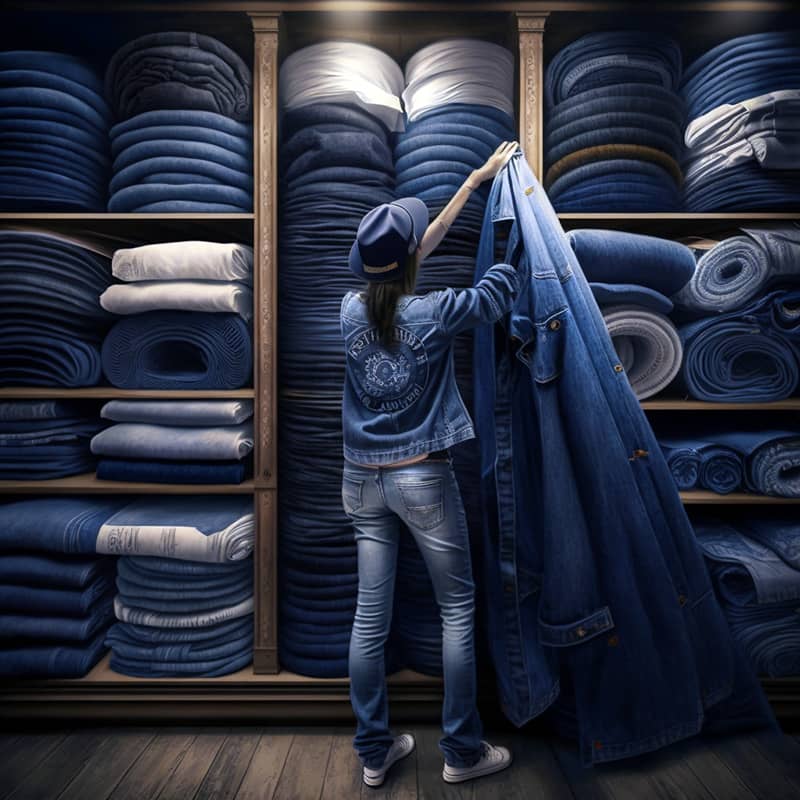Can you use denim for quilting? A Complete Guide
Denim is a popular fabric for many sewing projects, but it can also be used for quilting. This can be as a backing fabric, a main fabric for the quilt top, or as an accent fabric to add interest and texture to the design.
Denim quilting fabric is often made from a blend of cotton and polyester, which gives it the durability and strength of denim, but also allows it to be more flexible and easier to work with for quilting purposes. Quilting with denim is a popular choice for many quilters, as it adds a unique and rustic look to their projects.
When working with denim quilting fabric, it’s important to use the right needles and thread to ensure that the fabric is properly sewn. Denim is a heavier fabric than traditional quilting cotton, so it may require a heavier needle and thread to properly sew it. It’s also important to use sharp scissors or a rotary cutter to cut the denim fabric, as it can be difficult to cut with dull tools.

What is a denim quilt?
A denim quilt is a type of quilt that is made using denim fabric. The fabric used for denim quilts can be sourced from old jeans, denim scraps, or new denim fabric. Denim quilts are durable, long-lasting, and have a unique texture and appearance.
Denim quilts can be made in a variety of styles, from traditional patchwork to modern designs. Some common designs for denim quilts include the classic denim-on-denim look, where all of the fabric used is denim, and the denim and flannel quilt, which combines denim with soft, cozy flannel.
Denim quilts can also be embellished with embroidery, applique, or other decorative touches. Some quilters use decorative stitching or thread to create intricate patterns on the denim fabric.
Denim quilts are popular for their durability and versatility. They make great picnic blankets, couch throws, and bedspreads. Denim quilts are also a great way to repurpose old jeans and reduce waste.
Benefits of Using Denim for Quilting
There are many benefits to using denim for quilting, including:
- Durability – Denim is known for being a strong and sturdy fabric that can withstand a lot of wear and tear. This makes it a good choice for quilts that will be used frequently or that need to hold up to regular washing.
- Versatility – Denim comes in a variety of colors and patterns, making it easy to find the perfect shade for your project. Additionally, it can be paired with other fabrics to create unique designs and textures.
- Eco-Friendly – Using denim for quilting is an eco-friendly option, as it repurposes old jeans or other denim clothing items that would otherwise be thrown away.
- Cost-Effective – Denim is a relatively inexpensive fabric, making it an affordable choice for quilters on a budget.
- Easy to Care for – Denim is easy to care for and can be machine washed and dried.
“He may not be the flashiest superhero, but he’s definitely the strongest – thanks to his trusty denim suit!”

Tips for Quilting with Denim
- Pre-wash the fabric – Denim can shrink and bleed when washed, so it’s essential to pre-wash the fabric before using it in your quilt. This will prevent any unexpected surprises down the line.
- Use a walking foot – When sewing blocks together made from denim, it’s important to use a walking foot to prevent the layers of fabric from shifting as you sew.
- Choose the right needle – Denim is a thick fabric, so it’s important to use a needle that can handle the job. A size 90/14 or 100/16 needle is recommended for denim quilting.
- Plan your project carefully – Denim can be heavy and difficult to manipulate, so it’s important to plan your project carefully before starting. Consider using smaller pieces of denim or incorporating other fabrics into your design to make the quilt more manageable.
- Use a sturdy thread – When quilting with denim, it’s essential to use a extra strong thread that can handle the weight of the fabric.
- Practice your stitches – Because denim is a thick fabric, it can be more challenging to sew through than other fabrics. Practice your stitches on a scrap piece of denim before beginning your project to get a feel for the fabric and to adjust your tension as needed.
Techniques for Quilting with Denim
There are many techniques that can be used when quilting with denim. Here are a few popular options:
- Applique – Denim is a great fabric for applique because it is sturdy and holds its shape well. Consider using denim applique shapes to create a unique design on your quilt.
- Rag Quilts – Rag quilts are a popular choice for denim quilting because they showcase the frayed edges of the fabric. To make a rag quilt, simply sew squares of denim together with a layer of batting in between, and then snip the edges to create the frayed look. You can also check out our tutorial on making a rag quilt. It uses flannel but the same process applies.
- Mixed Media – Denim can be combined with other fabrics, such as cotton or flannel, to create a mixed media quilt. This can add texture and interest to your project and make it easier to work with the heavier denim fabric.
- Free-Motion Quilting – Free-motion quilting is a popular technique for denim quilting because it allows you to create intricate designs and textures on the fabric. To free-motion quilt, lower the feed dogs on your sewing machine and attach a darning or free-motion quilting foot. Then, move the fabric freely under the needle to create your design.
- Quilt-as-You-Go – Quilt-as-you-go is a technique that involves quilting each block individually and then sewing them together. This technique can be helpful when working with heavier fabrics like denim, as it reduces the bulk of the fabric during the quilting process.
Denim Quilt Design Ideas
There are many design ideas for denim quilts, here are a few to get you started:
- Patchwork – Denim patchwork quilts are a classic design that never goes out of style. They can be made with a variety of denim shades and patterns, or combined with other fabrics to add interest.
- Strip Quilts – Strip quilts are a quick and easy option for denim quilting. Simply sew strips of denim together and add batting and backing to create a simple yet stylish quilt.
- Chevron Pattern – A chevron pattern can be created with strips of denim and other fabrics. The angled lines create a bold and modern design that is perfect for a denim quilt.
- Log Cabin – The log cabin design is a popular choice for denim quilts because it showcases the different shades and textures of denim. By alternating light and dark shades, you can create a unique and eye-catching design.
- Denim and Lace – Denim can be paired with lace or other delicate fabrics to create a beautiful contrast. Consider using denim as a background fabric and adding lace applique shapes to create a soft and feminine design.
Cutting up old jeans to make a quilt
Cutting up old jeans is a great way to repurpose them into a beautiful and functional quilt. With a little bit of creativity and some basic sewing skills, you can create a unique and durable quilt that will last for years to come.

Here are some tips for cutting up old jeans:
- Choose the Right Jeans – Look for jeans that are in good condition with no holes or fraying. Avoid jeans with stretch or spandex in the fabric, as they can be difficult to work with. You can head over to your local opp shop/good will and purchase old jeans if you don’t have enough of your own. Choose jeans in larger sizes if you want bigger areas of fabric to work with.
- Wash and Dry – Before cutting up your jeans, be sure to wash and dry them to remove any dirt or stains. This will also soften the fabric, making it easier to work with.
- Cut Off Seams – Start by cutting off the seams from the legs and waistband of the jeans. This will give you flat pieces of denim to work with.
- Cut Squares or Strips – You can cut your denim into squares or strips, depending on the design of your quilt. To cut squares, use a rotary cutter and cutting mat to cut uniform pieces. To cut strips, use scissors or a rotary cutter to cut long, even strips.
- Mix and Match – Don’t be afraid to mix and match different shades and textures of denim in your quilt. This will add interest and depth to your design.
Once you have your denim pieces cut, you can begin piecing them together to create your quilt top. Remember to use a denim needle and strong thread when sewing your pieces together.
How to choose denim to make a quilt
Choosing the right denim for your quilt is an important step in creating a beautiful and functional finished product. Here are some things to consider when selecting denim for your quilt:

- Weight: Denim comes in a variety of weights, from lightweight to heavyweight. When choosing denim for your quilt, consider the weight of the fabric and how it will affect the overall feel and durability of the quilt. Heavyweight denim may be too thick and heavy for some projects, while lightweight denim may not be sturdy enough for others. A mid-weight denim is a good choice for most quilting projects.
- Color: Denim comes in a range of colors, from light blue to dark indigo, as well as black, white, and other colors. Consider the color scheme of your quilt and choose denim that will complement the other fabrics and colors in the quilt.
- Texture: Denim can have different textures, such as a smooth finish or a textured weave. Consider the overall look and feel of your quilt and choose denim that will enhance the texture and design of the quilt.
- Pre-washed or not: Some denim fabrics are pre-washed, which can affect the shrinkage and overall size of your quilt. If you’re using pre-washed denim, be sure to factor this into your quilt design and measurements.
- Upcycling: As we have already mentioned, you can repurpose old jeans or denim clothing to create a unique and sustainable quilt. This is a great way to give new life to old fabrics and add a personal touch to your quilt.
When selecting denim for your quilt, it’s important to choose high-quality fabrics that are durable and will hold up over time. Consider the weight, color, texture, and washing instructions when selecting denim for your project.
How to patchwork a denim quilt
- Choose your denim fabrics: Decide which denim fabrics you want to use for your patchwork quilt. You can use different washes of denim, or even incorporate other fabrics to add texture and interest to your quilt. Or you can use fabric from old jeans as mentioned above in this article.
- Cut your denim fabric into squares or rectangles: Cut your denim fabric into squares or rectangles of the same size, depending on the design you want for your quilt. You can use a rotary cutter and cutting mat to make the process faster and more accurate.
- Lay out your patchwork design: Once you have cut your denim fabric pieces, lay them out in the pattern you want for your quilt. You can experiment with different arrangements until you find the perfect design.
- Sew your denim pieces together: Once you have your patchwork design laid out, it’s time to start sewing the pieces together. Place two pieces of fabric right sides together and sew along one edge using a 1/4 inch seam allowance. Repeat until you have sewn all the pieces together in your design.
- Press your seams: After you have sewn your denim pieces together, press your seams flat with an iron. This will help your quilt lay flat and create a neat appearance.
- Add batting and a backing fabric: Once you have finished piecing your denim quilt top, add a layer of batting (see below for more info on batting) and a backing fabric. You can use any of the options mentioned earlier for backing, and choose a batting that works well with denim, such as a cotton or polyester blend.
- Quilt your denim patchwork: Finally, quilt your denim patchwork quilt by stitching the layers together. You can use any quilting technique you like, such as straight line quilting, free motion quilting, or hand quilting. Be sure to consider the weight of your quilt when choosing a quilting method.
Patching together a denim quilt can be a fun and rewarding project. With some planning, precision cutting, and careful sewing, you can create a beautiful patchwork quilt that is both stylish and functional.
Does a denim quilt need batting?
Batting is the layer of material that is sandwiched between the top and bottom layers of a quilt. It provides warmth and texture to the quilt, as well as helping to hold the layers together. However, when it comes to denim quilts, the use of batting is a matter of personal preference.
Denim is a thick and heavy fabric, and when used for quilting, it can provide enough warmth and texture on its own. Some quilters prefer not to use batting in their denim quilts, as it can make heavy. Additionally, during the quilting stage, a large, heavy quilt can be difficult to maneuver through a sewing machine, making it an arduous task to stitch the layers together.
On the other hand, some quilters do use batting in their denim quilts. Batting can add a layer of softness and loft to the quilt, making it more comfortable to use and adding some extra warmth.
If you do decide to use batting in your denim quilt, choose a batting that is appropriate for the weight and density of your denim fabric. Consider using a thin or low-loft batting (or you could even use flannel) to avoid adding too much bulk to your quilt.
Ultimately, the decision to use batting in your denim quilt is up to you. Consider the weight and texture of your denim fabric, as well as the overall look and feel that you want for your quilt. With or without batting, a denim quilt is a unique and functional addition to any home.
What type of backing can you use for a denim quilt?
When making a denim quilt, the backing fabric you choose can have a significant impact on the look and feel of the finished product. There are several options for backing fabrics that work well with denim quilts.
- Flannel: Flannel is a soft, cozy fabric that works well as a backing for denim quilts. It provides an extra layer of warmth and comfort, making the quilt perfect for snuggling up on the couch. Plus, the contrast between the soft flannel and rugged denim creates an interesting texture.
- Cotton: Cotton is a lightweight, breathable fabric that is commonly used as a backing for quilts. It comes in a variety of colors and patterns, allowing you to customize the look of your denim quilt. Cotton is also easy to work with and provides a smooth, even surface for quilting.
- Fleece: Fleece is a synthetic fabric that is soft, warm, and lightweight. It is an excellent choice for a backing if you want to add extra warmth to your denim quilt. Fleece comes in a variety of colors and patterns, and it is easy to work with.
- Minky: Minky is a plush, silky fabric that is incredibly soft and cozy. It makes an excellent backing for a denim quilt if you want to create a luxurious, snuggly feel. Minky is available in a variety of colors and patterns, and it is easy to work with.
- Denim: You can also use denim as a backing for your denim quilt. This creates a consistent look and texture throughout the quilt, and it provides an extra layer of durability. However, using denim as a backing can make the quilt quite heavy, so consider using a lightweight denim or pairing it with a lighter fabric.
Ultimately, the choice of backing fabric for your denim quilt will depend on your personal preference and the look and feel you want to achieve. Consider the texture, color, and weight of the fabric when making your decision. With the right backing, your denim quilt will be a unique and functional addition to your home.
What type of thread should you use for a denim quilt?
When choosing thread for your denim quilt, consider the weight and thickness of your fabric, as well as the sewing machine you’ll be using. Be sure to test your thread and stitch length on a scrap piece of denim before sewing your quilt to ensure the thread and machine can handle the thickness and weight of the fabric.
Here are some thread options to consider, however, it will really depend on the thickness of the denim you have used so you may need to test before committing yourself to a large quilt:
- Heavy-duty polyester thread: Polyester thread is a strong and durable option for sewing denim. Look for a heavy-duty or upholstery thread that is designed to handle thicker fabrics like denim. This type of thread is resistant to breakage and won’t shrink or fade over time.
- Cotton-wrapped polyester thread: If you prefer the look and feel of cotton thread, consider using a cotton-wrapped polyester thread. This thread has a cotton exterior that gives it a natural appearance, but the core is made of polyester, which adds strength and durability.
- Jeans/denim thread: Some manufacturers make a specific type of thread designed for sewing denim and jeans. This thread is usually thicker and stronger than regular thread, and it’s designed to handle the weight and thickness of denim fabric.
- Upholstery thread: If you’re working with very heavy denim or a combination of denim and other thick fabrics, upholstery thread may be the best option. Upholstery thread is designed for use on heavy fabrics and furniture, and it’s incredibly strong and durable.
How to bind a denim quilt
Binding is the finishing touch that gives a quilt its polished look.
NOTE: We have a complete tutorial on how to bind a quilt which so check that out.
Here’s how to bind a denim quilt:
- Choose your binding fabric: You can use any fabric you like for your binding, but a sturdy cotton or denim fabric will work well with your denim quilt. (Note that you probably won’t have enough denim binding if you are cutting your denim from jeans so an alternative will be needed.)
- Cut your binding strips: Cut your binding fabric into strips that are 2 1/4 inches wide and the length of your quilt’s perimeter plus 10 inches.
- Sew the binding strips together: Sew the binding strips together end-to-end, using a 1/4 inch seam allowance. Press the seams open.
- Fold the binding in half: Fold the binding in half lengthwise, wrong sides together, and press.
- Attach the binding to the quilt: Starting about halfway down one side of your quilt, align the raw edges of the binding with the raw edges of the quilt top. Leave a 6-inch tail of binding loose at the beginning. Using a 1/4 inch seam allowance, sew the binding to the quilt top, stopping 1/4 inch from the corner.
- Miter the corners: Fold the binding up at a 45-degree angle to form a diagonal fold. Then fold it back down along the next side, aligning the raw edges. Sew from the top edge down to the corner, stopping 1/4 inch from the edge. Repeat for all four corners.
- Finish the binding: Once you have sewn the binding all the way around the quilt, fold the raw edge of the binding to the back of the quilt and hand stitch it in place using a blind stitch. Tuck the loose ends of the binding into each other and sew them in place.
Your denim quilt is now complete with a neatly bound edge. Enjoy your cozy and stylish new creation!
Denim is a versatile and durable fabric that is perfect for quilting. Whether you’re creating a classic patchwork quilt or trying a more modern design, denim adds a unique and rustic look to any project. By following the tips and techniques outlined in this article, you’ll be able to create beautiful denim quilts that will stand the test of time. So, grab your denim scraps and get started on your next quilting project!